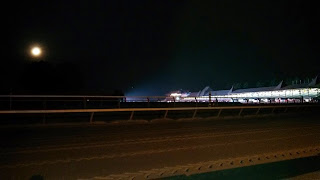Early to bed and early to rise makes a man healthy, wealthy
and wise. Is there such wisdom for those who watch the sun rise after working
the night?
Across America
people wake up to work the nightshift. It
is not the sole domain of the blue collar or unskilled laborer. Professionals
prowl the hours between 11 pm to seven in the morning. Doctors make their residencies in ER, airline
pilots trek coast to coast on the red eyes. International business people speak to call
centers a dozen time zones away. IT geeks tweak code; the independent writers
type out 500 word articles; DJs on local and national air waves stir tired imaginations
with spooky ramblings of international espionages, government conspiracies, UFO
kidnappings, the miracle of vitamin power and the spoils of Franken foods. With them are the traditional
over night workers – the factory employees make, shape and build America. The nocturnal long-haul truck driver rolls down
the center line, the janitor swabs bathrooms
and restocks the paper towels, the garbage collector clangs metal cans at the
street-side curb, the cab driver
delivers passengers and the security guard patrols long hallways, and the dark stairways
of warehouses, sky scrappers, office buildings, schools, wharfs and barns. (Some
barns have hallways and stairways.)
There is a whole industry of night beyond the making of
donuts and the printing of newspapers. It is of shipping and hauling product
and produce, of unpacking and stocking merchandise, of staging and positioning
packages for morning deliveries. These
activities ready the economy for the upcoming day. Nights make days and it is done by an
estimated three million Americans.
I’ve never worked a graveyard shift. I was in sweet dreamland long before the moon
rose and red traffic signals glared across the cityscapes with angry fiery eyes
like the devil himself. No one should
see creepy shadows run across open fields or lurk at the edges of forest. No
one should have to venture into poorly lit alleys or cross a street in the
echoes of their own foot steps. After
all, we know the story of Ichabod Crane.
As a teen I rose early. This might have had something to do
with my mom whose trigger finger on a light switch was faster than a bolt of
lightening on a golf course. It didn’t matter if it was a 6 am on a school day
or a weekend. When the slim thread of light stitched its pattern across the horizon
to reveal the green mountains of Vermont
it was time to rise and shine. Time to up and at’em. Time to make hay. And at
the other end of the day I got between the sheets early too. Even in the summer
before the sun sank below the crown of pine on the hill I “hit the hay”. To go to bed with the chickens. And chickens never worked the nightshift.
I love the morning. Full of promise. Long sun rays enrich the landscapes with
golden tones first caught on hill tops, then tree crowns and finally open
fields. The sounds of crickets and katydids fall silent to the birds’
song that seems to coax the sun into splendor..
In the dips and valleys cooler air settles as if it slept the
night away. There is an anticipation of
the morning lingering in the faded shadows of night. Mornings are fresh starts. They are daily do-overs.
Now I am on nightshift and lost. My mind and body are confused. It is like
having the “sleeping” me on Hawaii Time, but the “waking” me on Eastern. I wake at ten pm feeling the night, so aware
that what is ahead are more hours of darkness.
The crickets’ chirps sound like “sucker, sucker.” The moths dance in the yellow hues of
tungsten. Watching their futile flutter exhausts me. Kamikaze June bugs dive
bomb into the side of the guard shack. The whispered rustling of invisible trees is
unsettling. I feel the burden of summer
humidity sink in the low lands – damp and chilled. There are faint odors of disturbed circumstances:
a distant thunderstorm, a nest of skunk, the musky smell of horse and tilled
earth on a silent track.
This is where I chose to be. I traded the fevered excitement of the crowds gathered
in the grandstands clutching winning hopes on horses that breezed easily in the
soft blue light of dawn two days ago. Requests
to know the whereabouts of the nearest bathroom or ATM have been replaced with friendly
“good mornings” exchanged with grooms and exercise riders or semi-polite nods
from trainers and owners who flash ID cards with slight annoyance. The post parade has become a frenzied coordination
of horses, bicycles, golf carts, cars, vans and trucks across a busy
street.
And four days on the nightshift and I have not smelled one
cheap cigar. Just one more thing I don’t
miss about working days at the Saratoga Race Course. Wise move.













